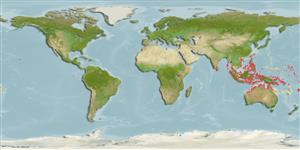>
Ovalentaria/misc (Various families in series Ovalentaria) >
Pomacentridae (Damselfishes) > Pomacentrinae
Etymology: Pomacentrus: Greek, poma, -atos = cover, operculum + Greek, kentron = sting (Ref. 45335).
More on author: Bleeker.
Environment: milieu / climate zone / depth range / distribution range
Ecología
marino asociado a arrecife; no migratorio; rango de profundidad 0 - 10 m (Ref. 7247). Tropical; 35°N - 35°S
Indo-West Pacific: Indonesia (Mentawai Islands), Philippines, Palau, Papua New Guinea, Solomon Islands, Vanuatu, north to the Philippines, Taiwan, and Ryukyu Islands. Reported from New Caledonia (Ref. 26587).
Tamaño / Peso / Age
Maturity: Lm ? range ? - ? cm
Max length : 7.0 cm SL macho / no sexado; (Ref. 7247)
Espinas dorsales (total): 13; Radios blandos dorsales (total): 14-16; Espinas anales 2; Radios blandos anales: 14 - 15.
Adults occur singly or in small aggregations at slightly turbid areas of lagoon and coastal reefs. Feed mainly on benthic algae (Ref. 7247). Oviparous, distinct pairing during breeding (Ref. 205). Eggs are demersal and adhere to the substrate (Ref. 205). Males guard and aerate the eggs (Ref. 205). Diurnal species (Ref. 52881).
Life cycle and mating behavior
Madurez | Reproducción | Puesta | Huevos | Fecundidad | Larva
Oviparous, distinct pairing during breeding (Ref. 205). Eggs are demersal and adhere to the substrate (Ref. 205). Males guard and aerate the eggs (Ref. 205).
Allen, G.R., 1991. Damselfishes of the world. Mergus Publishers, Melle, Germany. 271 p. (Ref. 7247)
IUCN Red List Status (Ref. 130435)
Threat to humans
Harmless
Human uses
Más información
ReferenciasAcuiculturaPerfil de acuiculturaRazasGenéticaElectrophoresesheritabilidadEnfermedadesProcesamientoNutrientsMass conversion
Herramientas
Special reports
Download XML
Fuentes de Internet
Estimates based on models
Preferred temperature (Ref.
123201): 26.9 - 29.3, mean 28.7 °C (based on 1958 cells).
Phylogenetic diversity index (Ref.
82804): PD
50 = 0.5000 [Uniqueness, from 0.5 = low to 2.0 = high].
Bayesian length-weight: a=0.02399 (0.01389 - 0.04142), b=2.93 (2.78 - 3.08), in cm total length, based on LWR estimates for this species & Genus-body shape (Ref.
93245).
Nivel trófico (Ref.
69278): 2.7 ±0.29 se; based on food items.
Resiliencia (Ref.
120179): Alto, población duplicada en un tiempo mínimo inferior a 15 meses (Preliminary K or Fecundity.).
Fishing Vulnerability (Ref.
59153): Low vulnerability (10 of 100).
Nutrients (Ref.
124155): Calcium = 161 [78, 256] mg/100g; Iron = 0.87 [0.51, 1.49] mg/100g; Protein = 18.2 [17.0, 19.3] %; Omega3 = 0.111 [0.062, 0.189] g/100g; Selenium = 18.2 [9.7, 36.3] μg/100g; VitaminA = 107 [30, 361] μg/100g; Zinc = 2.12 [1.39, 3.17] mg/100g (wet weight);
